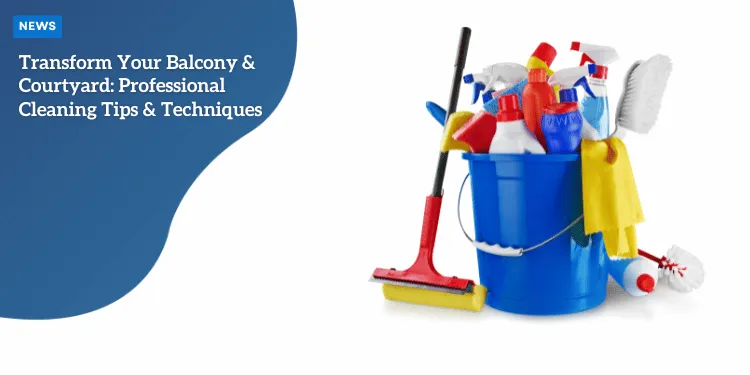Transform Your Balcony & Courtyard: Professional Cleaning Tips & Techniques

Anúncios
Gathering Necessary Cleaning Supplies and Equipment
The first step in transforming your balcony and courtyard into an inviting space is gathering the right cleaning supplies and equipment.
To start, you’ll need essential items like:
- A pressure washer or garden hose with an adjustable nozzle
- Buckets, broom, and a hard-bristle brush
- Gentle cleaning solutions specific to surface types (e.g., concrete cleaner, wood cleaner)
- A cobweb brush or broom for high and tight corners
- Degreaser for tough stains on pavers or tiles
- A squeegee with a microfibre cover for windows and glass doors
Having these items ready will ensure you are well-prepared to tackle the cleaning with efficiency.
Clearing the Area of Furniture and Removable Items
Before you get started with any cleaning, it’s important to clear the space of any furniture and removable items.
Anúncios
Professionals like Kate Croukamp recommend starting with a thorough decluttering, as it can help you feel less overwhelmed by the task ahead.
Remove outdoor furniture, cushions, planters, and anything else that might get in the way or could be damaged by water.
Take this opportunity to sort through the items and discard any junk that no longer serves a purpose.
Inspecting Surfaces for Damage and Specific Cleaning Needs
With the area cleared, inspect all surfaces for any damage or specific cleaning requirements.
Look out for cracks, loose tiles, or areas with significant grime build-up.
Anúncios
Identifying these issues early on will help you choose the appropriate cleaning methods and tools.
Pay special attention to areas prone to moss, mildew, or algae growth, as well as surfaces that may need particular cleaning solutions like a degreaser for oily stains.
Conducting this inspection will ensure you address all the unique needs of your outdoor space, setting the stage for a thorough and effective cleaning process.
By being well-prepared and orderly with these steps, you’re not only setting yourself up for success but also ensuring a smoother, more efficient cleaning session.
This methodical approach will significantly streamline the work and help achieve the desired transformation of your outdoor space.
Surface-Specific Cleaning Techniques
Giving your balcony or courtyard a thorough cleaning can do wonders for its appearance and longevity.
Each surface material—whether concrete, tile, or wood—requires specific cleaning methods to achieve optimal results.
Here’s how you can tackle each type effectively.
Cleaning Different Flooring Materials
Concrete
Concrete surfaces are durable but can accumulate grime and stains over time.
To clean concrete:
- Start by sweeping or vacuuming any loose debris.
- Use a pressure washer for deep cleaning, ensuring it’s set to the appropriate pressure to avoid surface damage.
- If a pressure washer isn’t available, scrub the area with a stiff-bristle brush and a solution of dish soap and water.
- For stubborn stains, apply a concrete cleaner or degreaser, letting it sit for 15-20 minutes before scrubbing again.
Tile
Tile flooring is relatively easy to clean but requires care to maintain its grout.
Follow these steps:
- Sweep or vacuum the area to remove loose dirt.
- Mop the tiles with a mild detergent mixed with warm water, ensuring a thorough rinse to avoid residue buildup.
- For grout, use a grout cleaner and a small stiff brush to scrub out stains.
- Rinse the area well with clean water to remove any soap residue.
Wood
Wooden surfaces need gentle yet effective cleaning to preserve their texture and finish.
Here’s how:
- Sweep the area with a soft broom to remove leaves, dust, and debris.
- Mix a solution of wood cleaner and water according to the manufacturer’s instructions.
- Gently scrub the surface with a soft-bristle brush, ensuring you follow the grain of the wood.
- Rinse off the cleaning solution thoroughly with a garden hose, and let it dry completely.
Proper Cleaning Solutions for Various Surface Types
Different surfaces necessitate different cleaning solutions for the best results:
- Concrete Cleaner: For a deep clean, use a specially formulated concrete cleaner or degreaser.
- Tile Cleaner: A mild detergent mixed with warm water works well, or choose grout-specific cleaners for grout lines.
- Wood Cleaner: Use a wood-specific cleaner to avoid damaging the surface or affecting the wood’s natural oils.
Tackling Stubborn Stains and Discoloration
Outdoor areas can suffer from stubborn stains and discoloration due to various factors.
Here’s how to deal with them:
- Moss, Mildew, and Algae Growth: Use a mold and mildew remover to spray the affected areas. Let it sit for about 15-20 minutes before scrubbing and rinsing thoroughly. This step is crucial to prevent regrowth.
- Grease Spots: Especially common near barbecues, grease spots can be challenging. Apply a degreaser and let it sit for a while before scrubbing it off.
- General Discoloration: For general fading or staining, ensure you use the right cleaning solution for your specific surface type and follow up with a thorough rinse.
Maintaining your outdoor areas not only enhances their appearance but also extends their lifespan.
By using the right techniques and solutions for different surfaces, you ensure a cleaner and more appealing outdoor space.
Next, we will delve into addressing environmental challenges that these areas often face, such as removing moss, mildew, and dealing with pest residues.
Dealing with Environmental Challenges
Removing Moss, Mildew, and Algae Growth
Outdoor spaces can often become breeding grounds for moss, mildew, and algae.
To tackle these pests, begin with a thorough cleaning:
- Pressure Washing: Use a pressure washer to blast away moss, mildew, and algae. This is effective on concrete and tile surfaces. Be cautious when applying pressure to prevent damaging the surface.
- Cleaning Solutions: For stubborn growth, apply a mold and mildew cleaner. Let it sit for 15-20 minutes before scrubbing and rinsing off.
- Preventative Measures: Keeping the area dry and ensuring good airflow can help prevent future growth. Consider repositioning plants and furniture to reduce moisture buildup.
Addressing Bird Droppings and Pest Residue
Bird droppings and other pest residues can be a nuisance and unsanitary.
- Initial Cleaning: Start by removing any solid droppings using a plastic scraper and dispose of them properly.
- Cleaning Solutions: Mix a solution of water and dish soap or use a specialized bird dropping cleaner. Apply to the affected areas and scrub with a brush.
- Rinsing: Rinse the area with water and allow it to dry. For persistent stains, you may need to repeat the process or use a stronger cleaner.
Preventing Water Damage and Drainage Issues
Proper water management is crucial for maintaining the longevity of your outdoor space.
- Inspect Drainage: Ensure that all drains are clear of debris to prevent water buildup. Regularly check and clean gutters and downspouts.
- Seal Surfaces: Apply a water-repellent sealant to porous surfaces like wood or concrete to protect against water damage. Reapply as necessary per the manufacturer’s instructions.
- Avoid Pools of Water: Arrange furniture and planters so that water doesn’t pool in one spot. Elevate pots and use trays to catch excess water.
By staying vigilant and addressing these environmental challenges promptly, you can keep your balcony and courtyard looking their best and ensure their durability for years to come.
Next, we will explore the best practices for taking care of furniture and fixtures in your outdoor living spaces.
Furniture and Fixture Care
Cleaning Outdoor Furniture and Cushions
Cleaning outdoor furniture and cushions is vital to maintaining a neat and inviting outdoor space.
Start by removing any loose dirt with a vacuum or brush.
For fabric cushions, a mild soap solution and a soft brush can help remove stains and grime.
Rinse thoroughly and let them dry completely in the sun to prevent mildew growth.
While for other furniture materials such as plastic, metal, or wood, a bucket of warm soapy water and a soft cloth can deliver great results.
Avoid abrasive cleaners that may damage the surfaces.
For stubborn stains, consider using a mix of water and white vinegar or a specialized cleaner suitable for the specific material.
Maintaining Light Fixtures and Railings
Outdoor light fixtures and railings can accumulate dust and grime quickly.
Cleaning these regularly ensures they remain functional and aesthetically pleasing.
Use a soft cloth and mild detergent to clean fixtures, paying special attention to any glass panels.
A small brush can help reach tight spaces and remove cobwebs or dirt.
Railings, whether metal or wood, require special care.
For metal railings, a gentle scrubbing with a mix of water and mild detergent can keep them free of rust and debris.
Wooden railings benefit from a gentle clean with soapy water and a soft brush, followed by a thorough rinse and drying to avoid waterlogging.
Restoring Metal and Wood Features
Restoring the look of metal and wood features takes more than just cleaning.
For metal surfaces showing signs of rust, a rust remover or a mixture of vinegar and baking soda can be effective.
Scrub gently with steel wool or a wire brush, then rinse and let dry entirely.
Applying a rust-resistant primer and paint can further protect the metal.
Wooden features, on the other hand, may suffer from fading or damage from the elements.
Start by sanding any rough spots and cleaning the surface with soapy water.
Once dry, apply a wood sealant or stain to restore color and protect against future weathering.
Regular maintenance with these treatments can keep wood looking fresh and prolong its lifespan.
Transitioning from furniture and fixture care, regular upkeep is key to retaining the charm and longevity of your outdoor areas.
The next chapter will delve into creating a cleaning schedule tailored to different seasons, ensuring preventive measures to reduce the frequency of deep cleaning.
Regular Maintenance Tips
Creating a Cleaning Schedule for Different Seasons
To keep your balcony and courtyard looking immaculate year-round, it’s essential to have a cleaning schedule tailored to each season.
During spring, focus on deep cleaning to remove debris accumulated over winter.
Include tasks such as pressure washing surfaces, cleaning outdoor furniture, and inspecting for any winter damage.
Summer is about maintenance. Weekly tasks should include sweeping and wiping down furniture.
Monthly tasks might involve washing windows, clearing cobwebs, and addressing any moss or mildew growth that could occur in humid conditions.
As fall approaches, focus on removing leaves and debris to prevent stains and water damage.
It’s also a good time to apply protective treatments to wood and metal fixtures, preparing them for winter’s harsh conditions.
Winter maintenance should be minimal due to cold weather, concentrating mainly on keeping walkways clear of snow and ice to prevent slips.
Preventive Measures to Reduce Deep Cleaning Frequency
Implement preventive measures to minimize the need for deep cleaning.
First, consider applying a sealant to surfaces like concrete and wood to protect them from stains and weather elements.
Regularly check for and remove any standing water to prevent mold and mildew growth.
Using outdoor rugs or mats in high-traffic areas can trap dirt and reduce wear on the flooring underneath.
For furniture, investing in protective covers when not in use shields them from dust and weather damage, extending their lifespan.
Quick Daily Maintenance Routines
A quick daily maintenance routine can keep your outdoor area in top shape.
Start by sweeping away leaves, dust, and debris from all surfaces.
Wipe down tables, chairs, and railings with a damp cloth to remove grime and bird droppings.
Once a week, take a few extra minutes to inspect the area for any signs of mold or mildew and treat it immediately.
Watering plants and cleaning up after them should be part of your regular routine to ensure they don’t contribute to mess and clutter.
These simple steps will keep your balcony and courtyard welcoming and reduce the need for more intensive cleaning sessions later on.
Continue with the next chapter focusing on safety and environmentally-friendly practices to ensure a balanced approach to maintaining your outdoor spaces.
Safety and Environmental Considerations
Using Eco-Friendly Cleaning Products
Cleaning outdoor spaces doesn’t have to be harsh on the environment.
Opt for eco-friendly cleaning products to keep your balcony and courtyard pristine while ensuring you are not harming nature.
Many brands now offer biodegradable and plant-based cleaners that work effectively without toxic chemicals.
When shopping, look for products labeled as eco-friendly or non-toxic.
For example, you can create a natural cleaning solution using simple household items.
Mix vinegar and water in equal parts to clean glass surfaces and handle stubborn stains.
Baking soda and water form an excellent paste for scrubbing tough grime on concrete or tile without resorting to harsh chemicals.
Ensuring Proper Drainage During Cleaning
Proper drainage is crucial when cleaning to avoid water pooling and potential damage.
Before you start, inspect the area for existing drainage systems, such as gutters and drain holes.
Ensure they are clear of debris to allow water to flow freely.
When using water for cleaning, consider using a hose with a nozzle that allows you to control the pressure and spray direction.
This helps to focus the cleaning on specific areas while minimizing excessive water use.
In situations where water runoff might be an issue, like on apartment balconies, manual cleaning methods can be highly effective.
Sweep up dust and debris first, then use a bucket of water and a brush to clean the surfaces in manageable sections to prevent water buildup.
Safety Precautions for Elevated Areas
When working on elevated areas like balconies, safety should be your top priority.
Ensure the area is structurally sound before you begin, checking for any loose railings or damaged flooring.
If you need to use a ladder, always position it on a stable surface and have someone assist you for added security.
Avoid using power equipment near the edges to prevent accidents. Instead, opt for manual tools like brooms, mops, and scrub brushes.
Moreover, make sure the area is well-lit, especially if you are working in the early morning or late evening, to avoid tripping hazards.
Following these eco-friendly and safety guidelines ensures you can maintain your outdoor spaces effectively without adverse impacts on the environment or risking personal injury.
This comprehensive approach not only keeps your areas clean and safe but also sustains their beauty over time.






